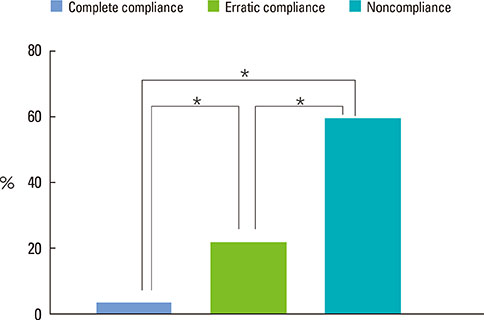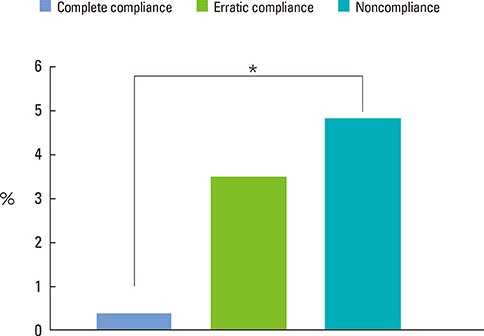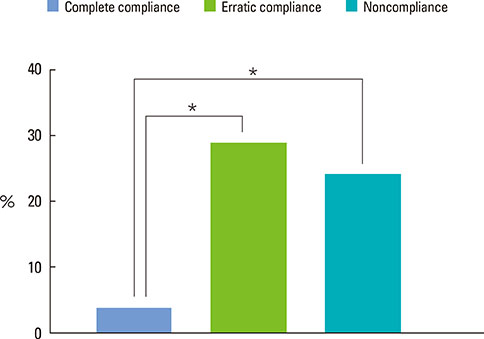J Periodontal Implant Sci.
2014 Apr;44(2):65-70. 10.5051/jpis.2014.44.2.65.
Effect of supportive periodontal therapy on the prevention of tooth loss in Korean adults
- Affiliations
-
- 1Department of Periodontology, Research Institute of Oral Sciences, Gangneung-Wonju National University College of Dentistry, Gangneung, Korea. hsum@gwnu.ac.kr
- KMID: 1914506
- DOI: http://doi.org/10.5051/jpis.2014.44.2.65
Abstract
- PURPOSE
The purpose of this retrospective study was to evaluate the effect of patient compliance with supportive periodontal therapy (SPT) on tooth loss in Korean adults.
METHODS
The periodontal records of 134 patients were reviewed for this study. They completed active periodontal treatment from 1999 to 2001 and were placed on a schedule of periodic follow-up visits for SPT. Patient compliance was classified into complete compliance (CC), erratic compliance (EC), and noncompliance (NC) groups. Re-examinations were carried out 11.0+/-0.8 years after the active periodontal treatment. The prognosis for each tooth was determined as good, questionable, or hopeless according to the bone loss observed in pretreatment radiographs.
RESULTS
The rate of tooth loss of the CC group was significantly lower than that of the NC group. The tooth loss/patient and the tooth loss/patient/year were not significantly different between the three groups. The rates of tooth loss in the good, questionable, and hopeless prognosis groups were 6.7%, 9.5%, and 13.2%, respectively. For the teeth with a good prognosis, the rate of tooth loss of the CC group was significantly lower than that of the NC group (0.4% vs. 5.1%). For the teeth with a questionable prognosis, the CC group showed a significantly lower rate of tooth loss than did the EC group (4.1% vs. 30.7%) or the NC group (4.1% vs. 25.6%). For the teeth with a hopeless prognosis, the rates of tooth loss were not significantly different among the three groups.
CONCLUSIONS
Within the limits of this study, the patients who showed a poor compliance with SPT were more likely to lose teeth than were the regularly compliant patients. However, the risk of tooth loss with a hopeless prognosis was high irrespective of the compliance.
Keyword
MeSH Terms
Figure
Cited by 1 articles
-
Evaluation of prognosis related to compliance with supportive periodontal treatment in patients with chronic periodontitis: a clinical retrospective study
Jong-Bin Lee, Hye-Jung Shin, Dae-Yeob Kim, Eun-Kyoung Pang
J Periodontal Implant Sci. 2019;49(2):76-89. doi: 10.5051/jpis.2019.49.2.76.
Reference
-
1. Hujoel PP, Leroux BG, Selipsky H, White BA. Non-surgical periodontal therapy and tooth loss: a cohort study. J Periodontol. 2000; 71:736–742.
Article2. Pihlstrom BL, McHugh RB, Oliphant TH, Ortiz-Campos C. Comparison of surgical and nonsurgical treatment of periodontal disease: a review of current studies and additional results after 61/2 years. J Clin Periodontol. 1983; 10:524–541.
Article3. American Academy of Periodontology. Glossary of periodontal terms. Chicago: American Academy of Periodontology;2001.4. Sackett DL, Haynes RB. Compliance with therapeutic regimens. Baltimore: Johns Hopkins University Press;1977.5. Wilson TG Jr, Glover ME, Schoen J, Baus C, Jacobs T. Compliance with maintenance therapy in a private periodontal practice. J Periodontol. 1984; 55:468–473.
Article6. Mendoza AR, Newcomb GM, Nixon KC. Compliance with supportive periodontal therapy. J Periodontol. 1991; 62:731–736.
Article7. Demetriou N, Tsami-Pandi A, Parashis A. Compliance with supportive periodontal treatment in private periodontal practice. A 14-year retrospective study. J Periodontol. 1995; 66:145–149.
Article8. Novaes AB, Novaes AB Jr, Moraes N, Campos GM, Grisi MF. Compliance with supportive periodontal therapy. J Periodontol. 1996; 67:213–216.
Article9. Park WK, Lee JK, Chang BS, Um HS. A retrospective study on patients' compliance with supportive periodontal therapy. J Korean Acad Periodontol. 2009; 39:59–70.
Article10. Costa FO, Miranda Cota LO, Pereira Lages EJ, Vilela Camara GC, Cortelli SC, Cortelli JR, et al. Oral impact on daily performance, personality traits, and compliance in periodontal maintenance therapy. J Periodontol. 2011; 82:1146–1154.
Article11. Miyamoto T, Kumagai T, Jones JA, Van Dyke TE, Nunn ME. Compliance as a prognostic indicator: retrospective study of 505 patients treated and maintained for 15 years. J Periodontol. 2006; 77:223–232.
Article12. Ramfjord SP, Morrison EC, Burgett FG, Nissle RR, Shick RA, Zann GJ, et al. Oral hygiene and maintenance of periodontal support. J Periodontol. 1982; 53:26–30.
Article13. Konig J, Plagmann HC, Langenfeld N, Kocher T. Retrospective comparison of clinical variables between compliant and non-compliant patients. J Clin Periodontol. 2001; 28:227–232.
Article14. Fardal O, Johannessen AC, Linden GJ. Tooth loss during maintenance following periodontal treatment in a periodontal practice in Norway. J Clin Periodontol. 2004; 31:550–555.
Article15. Checchi L, Montevecchi M, Gatto MR, Trombelli L. Retrospective study of tooth loss in 92 treated periodontal patients. J Clin Periodontol. 2002; 29:651–656.
Article16. Eickholz P, Kaltschmitt J, Berbig J, Reitmeir P, Pretzl B. Tooth loss after active periodontal therapy. 1: patient-related factors for risk, prognosis, and quality of outcome. J Clin Periodontol. 2008; 35:165–174.
Article17. Wilson TG Jr, Glover ME, Malik AK, Schoen JA, Dorsett D. Tooth loss in maintenance patients in a private periodontal practice. J Periodontol. 1987; 58:231–235.
Article18. Shick RA. Maintenance phase of periodontal therapy. J Periodontol. 1981; 52:576–583.
Article19. Lindhe J, Nyman S. Long-term maintenance of patients treated for advanced periodontal disease. J Clin Periodontol. 1984; 11:504–514.
Article20. Hirschfeld L, Wasserman B. A long-term survey of tooth loss in 600 treated periodontal patients. J Periodontol. 1978; 49:225–237.
Article21. Tsami A, Pepelassi E, Kodovazenitis G, Komboli M. Parameters affecting tooth loss during periodontal maintenance in a Greek population. J Am Dent Assoc. 2009; 140:1100–1107.
Article22. Ng MC, Ong MM, Lim LP, Koh CG, Chan YH. Tooth loss in compliant and non-compliant periodontally treated patients: 7 years after active periodontal therapy. J Clin Periodontol. 2011; 38:499–508.
Article23. McFall WT Jr. Tooth loss in 100 treated patients with periodontal disease: a long-term study. J Periodontol. 1982; 53:539–549.
Article24. Goldman MJ, Ross IF, Goteiner D. Effect of periodontal therapy on patients maintained for 15 years or longer: a retrospective study. J Periodontol. 1986; 57:347–353.
Article25. Kwok V, Caton JG. Commentary: prognosis revisited: a system for assigning periodontal prognosis. J Periodontol. 2007; 78:2063–2071.
Article26. Becker W, Becker BE, Berg LE. Periodontal treatment without maintenance: a retrospective study in 44 patients. J Periodontol. 1984; 55:505–509.
Article27. McGuire MK. Prognosis versus actual outcome: a long-term survey of 100 treated periodontal patients under maintenance care. J Periodontol. 1991; 62:51–58.
Article28. Avila G, Galindo-Moreno P, Soehren S, Misch CE, Morelli T, Wang HL. A novel decision-making process for tooth retention or extraction. J Periodontol. 2009; 80:476–491.
Article29. Miyamoto T, Kumagai T, Lang MS, Nunn ME. Compliance as a prognostic indicator. II. Impact of patient's compliance to the individual tooth survival. J Periodontol. 2010; 81:1280–1288.
Article30. Baumer A, Pretzl B, Cosgarea R, Kim TS, Reitmeir P, Eickholz P, et al. Tooth loss in aggressive periodontitis after active periodontal therapy: patient-related and tooth-related prognostic factors. J Clin Periodontol. 2011; 38:644–651.
Article31. Fardal O, Linden GJ. Tooth loss and implant outcomes in patients refractory to treatment in a periodontal practice. J Clin Periodontol. 2008; 35:733–738.
Article32. Hujoel PP. Endpoints in periodontal trials: the need for an evidence-based research approach. Periodontol 2000. 2004; 36:196–204.
Article33. Ong G. Periodontal disease and tooth loss. Int Dent J. 1998; 48:3 Suppl 1. 233–238.
Article34. Papapanou PN, Lindhe J. Epidemiology of periodontal disease. In : Lindhe J, Lang NP, Karring T, editors. Clinical periodontology and implant dentistry. 5th ed. Oxford: Blackwell Munksgaard;2008. p. 129–179.
- Full Text Links
- Actions
-
Cited
- CITED
-
- Close
- Share
- Similar articles
-
- Patient related and tooth related risk factor of tooth loss after periodontal surgical treatment - prospective study
- Treatment of a tooth with severe periodontal involvement using intentional replantation: case report
- Orthodontic treatment using indirect bonding technique in periodontitis
- Study on tooth mortality after periodontal therapy
- Comparison of tooth loss after periodontal treatment using the 1999 and 2018 systems of periodontal disease classification: a retrospective longitudinal study with over five years of follow-up





